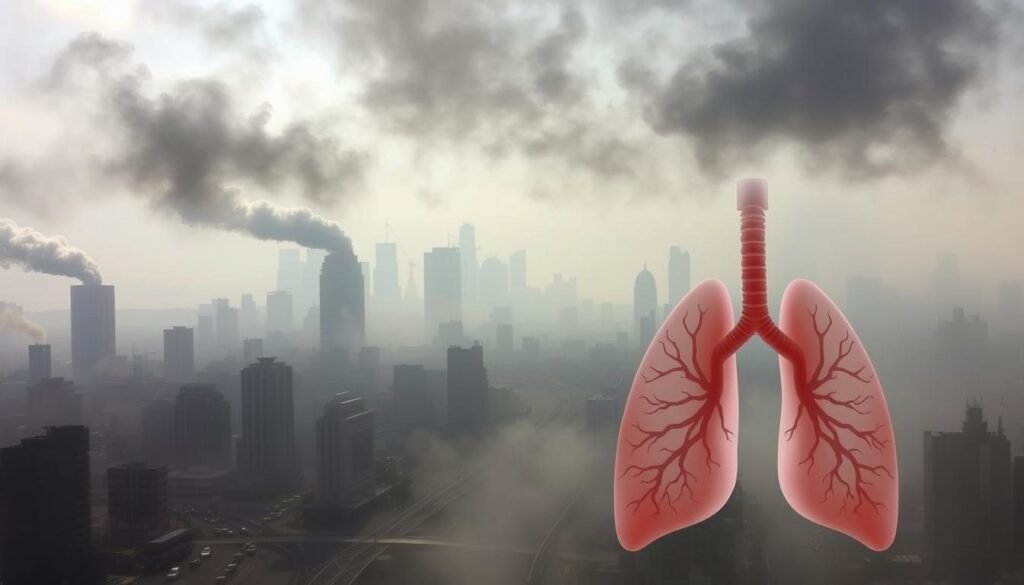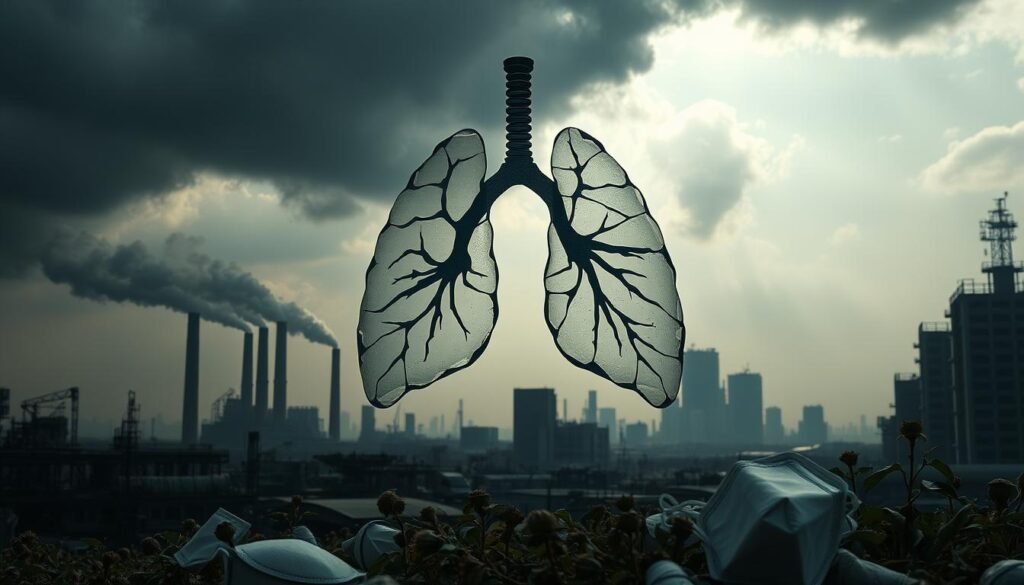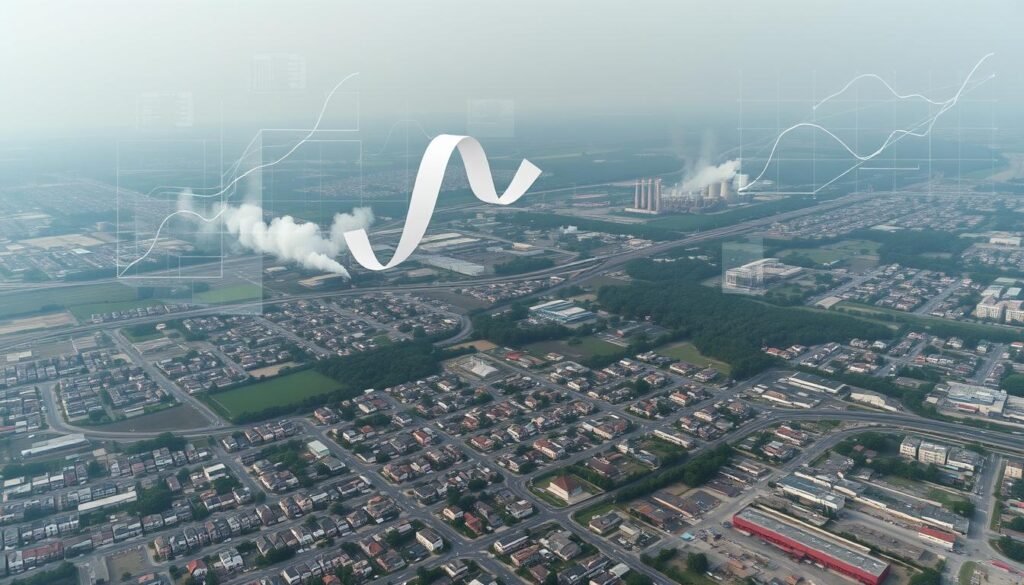Lung cancer makes up 11.6% of all cancer cases around the world. It has a survival rate of only 10% five years after diagnosis. Considering these figures, it’s crucial to look into how our environment affects lung cancer rates. Over 108,000 people die each year from lung cancer due to outdoor air pollution. Second-hand smoke and solid fuels also play a big role. As the number one cancer worldwide, it’s important to understand how environmental factors influence lung health.
Recent studies have found links between lung cancer and different pollutants. These findings could help us prevent cancer. But, because people live in varied places and lifestyles, we need to keep researching. This article will talk about the latest in lung cancer and environmental exposure. We will see how these factors impact health and the risk of getting lung cancer.
Key Takeaways
- Lung cancer represents 11.6% of all cancer cases globally.
- 80% of lung cancer cases can be attributed to smoking.
- Outdoor pollution and other environmental factors cause tens of thousands of lung cancer deaths each year.
- Early detection of lung cancer is crucial for improving survival rates.
- Research continues to uncover the links between environmental exposure and lung cancer risk.
- Only 1 out of 10 patients diagnosed with lung cancer survive five years post-diagnosis.
Understanding Lung Cancer: A Global Perspective
Lung cancer is a major health issue around the world. GLOBOCAN 2018 reports show lung cancer is the top cause of death from cancer globally. It makes up about 11.6% of all new cancer cases. Every year, doctors find over 2.1 million new cases.
Most of these, around 80% in rich countries, are due to smoking. But, rates of lung cancer in non-smokers are also rising. This increase points to the dangers of pollution and work-related risks.
Statistics on Lung Cancer Incidence and Mortality
The picture of lung cancer differs greatly around the world. In poorer countries, it’s often caught too late, which lowers chances of survival. Sadly, only 1 in 10 people diagnosed will survive more than five years.
Outdoor air pollution causes about 108,000 deaths from lung cancer each year. Second-hand smoke adds another 21,000 deaths. Also, solid fuels, common in developing areas, are linked to 36,000 deaths.
| Statistic | Figures |
|---|---|
| Lung cancer cases globally (annually) | Over 2.1 million |
| Percentage of lung cancer cases linked to smoking | 80% |
| Estimated lung cancer deaths due to outdoor air pollution | 108,000 |
| Annual lung cancer cases reported in India | 114,000 |
| Survival rate after 5 years | 10% |
Increasing Rates Among Non-Smokers
The increase in lung cancer among non-smokers is worrying. The rate for non-smokers, especially women aged 40 to 79, is between 14.4 and 20.8 per 100,000 person-years. About 15% of lung cancer in men comes from job-related exposure. In women, it’s about 5%.
Hazardous air and chemicals are big risk factors. In the US, less than 10% of 80,000 chemicals have been tested for safety. Reducing these risks could save up to 1.7 million lives a year from different cancers.
To understand more about these numbers and their impact, exploring the global situation of lung cancer is key to fighting this disease.
Environmental Exposure and Lung Cancer
It’s important to understand how our environment affects lung cancer risks. Our environment has many things that can hurt our lungs. This includes polluted air, harmful chemicals, and radiation. All these factors play a part in raising lung cancer rates.
Defining Environmental Exposure
Environmental exposure is about the harmful stuff we come in contact with. It’s the bad substances in our surroundings that can damage our lung health. Factories, cities, and even our homes contribute to this problem. Knowing about these risks can help us fight lung cancer better.
Types of Environmental Pollutants Affecting Lung Health
Many pollutants play a big role in increasing lung cancer. Key ones include:
- Particulate Matter (PM2.5): These tiny particles get deep into our lungs and cause serious problems.
- Sulfur Dioxide (SO2): This gas comes from power plants and can make lung conditions worse.
- Nitrogen Dioxide (NO2): It mainly comes from cars. Being around it too much can increase cancer risks.
- Carbon Monoxide (CO): This dangerous gas comes from burning fuels not completely.
- Radon: This radioactive gas comes from the earth and is a big risk for non-smokers.
The connection between these pollutants and lung cancer is clear, especially in cities and industrial areas. By knowing more and reducing our exposure, we can lower lung cancer risks.
| Pollutant | Source | Health Impact |
|---|---|---|
| Particulate Matter (PM2.5) | Diesel exhaust, power plants | Increases lung cancer risk |
| Sulfur Dioxide (SO2) | Industrial emissions, power generation | Aggravates respiratory conditions |
| Nitrogen Dioxide (NO2) | Vehicle emissions | Heightens lung cancer risk |
| Carbon Monoxide (CO) | Burning fuels | Depletes oxygen supply in the body |
| Radon | Natural decay of uranium | Second-leading cause of lung cancer |
Ionizing Radiation and Lung Cancer
Ionizing radiation is a big risk for lung cancer. Knowing about its sources and effects helps with public health. It’s important to know where radiation exposure comes from to protect people at risk.
Sources of Ionizing Radiation
Many things cause ionizing radiation exposure. The main ones include:
- Radon: A gas found naturally that can build up in homes, especially basements.
- Ambient Air Pollution: Environmental pollutants emit beta particles, adding to radiation levels.
- Medical Procedures: While helpful for diagnosis, X-rays and CT scans increase radiation you’re exposed to.
Impact of Radiation Exposure on Cancer Survival Rates
Studies link ionizing radiation to how long lung cancer patients live. One major study looked at uranium miners. It showed how radon exposure raises lung cancer death risks. This was clear even in miners exposed to low radon levels.
The increase in lung cancer risk was directly tied to how much radon they were exposed to. This proves we need to be aware of these dangers. The study also wants to explore other cancers linked to radiation exposure.
This information makes it clear how environmental radiation plays a role in lung cancer. Knowing about these sources and their dangers is crucial. This knowledge helps us develop plans to reduce exposure and better health overall.
Outdoor Air Pollution: A Major Contributor
Outdoor air pollution is a big health risk, especially for lung cancer. Fine particles, known as PM2.5, are very dangerous for our lungs. These tiny particles can go deep into our lungs to where oxygen gets into our blood.
Particulate Matter and Lung Cancer
Many lung cancer deaths around the world are due to outdoor air pollution. PM2.5 particles play a big part in this. A study shows an increased risk of lung cancer with more PM2.5 in the air. The risk is even higher for people who used to smoke.
PM2.5 and PM10 particles are especially harmful to kids, the elderly, and former smokers. Research shows they are all at greater risk.
Outdoor Pollutants Linked to Poor Cancer Outcomes
Some main pollutants are sulfur dioxide, nitrogen dioxide, and ozone. These come from factories and cars. Coal and diesel vehicles then add to the air pollutants, making cancer risks go up. The WHO says these pollutants are bad for our lung health.

| Source of Pollutant | Type of Particulate Matter | Impact on Cancer Outcomes |
|---|---|---|
| Coal Combustion | PM2.5 | Increases lung cancer risk significantly |
| Vehicle Emissions | NO2, PM2.5 | Linked to higher lung cancer incidence |
| Biomass Burning | PM2.5 | Contributes to indoor and outdoor air pollution |
| Industrial Emissions | Mercury, Lead | Significant risk factor for lung cancer |
In the United States, cleaner air is linked to better lung cancer survival rates, thanks to laws like the Clean Air Act. It’s vital we keep researching the effects of outdoor air pollution on our lungs.
Occupational Hazards and Lung Cancer Risk
Many workers face chemical exposures that can lead to lung cancer. Substances like arsenic, cadmium, and benzene are particularly harmful. It’s important to know about these risks and follow safety rules at work.
Chemical Exposures in the Workplace
In jobs like construction, mining, and manufacturing, workers come into contact with dangerous chemicals. These include asbestos, silica, nickel, chromium(VI), and PAHs. When exposed to these substances, the risk of lung cancer goes up.
The danger increases when workers are exposed to multiple chemicals. This can cause a combined effect, making the situation even more risky. For instance, chromium(VI) and silica together are especially harmful.
Industries with High Lung Cancer Incidence
Some jobs have a higher chance of lung cancer because of chemical dangers. The chart below shows some industries with these risks:
| Industry | Chemical Exposures | Risk Factors |
|---|---|---|
| Construction | Asbestos, silica | Asbestos-related lung cancer, silicosis |
| Mining | Coal dust, arsenic | Coal workers’ pneumoconiosis, lung cancer |
| Manufacturing | Nickel, chromium(VI) | Respiratory diseases, lung cancer |
| Pulp and Paper | PAHs | Increased lung cancer risk |
Certain jobs carry a higher lung cancer risk because of the chemicals used. Making workplaces safer and following strict rules is key to lowering lung cancer rates among workers.
Case Studies: Environmental Exposure Impacts
Environmental case studies show how pollution links to lung cancer. They tell us how our surroundings play a role in lung cancer cases. This is crucial for both local and global insights.
Local Epidemiology Studies
A big review of local studies found a clear link between pollution and lung cancer. One study looked at 767 lung cancer patients who never smoked and their controls. It found that pollution really impacts lung cancer rates.
Especially, a family history of lung cancer means a higher chance of getting it. Also, people with asthma face even bigger risks when exposed to pollution. This shows how certain conditions can make pollution effects worse.
Global Findings on Pollution and Lung Cancer Correlations
Around the world, studies have explored how pollution affects lung cancer. The World Health Organization reports lung cancer is the second most common cancer globally. In 2020, it caused about 1.8 million deaths.
Places with a lot of pollution saw more lung cancer linked to environmental exposure. But, cleaner areas had fewer cases. This tells us that better pollution control can reduce lung cancer risks.

Secondary Malignancies: Lung Cancer after Breast Radiation
Women treated for breast cancer see survival benefits from radiotherapy. Yet, they should know about the risk of getting lung cancer later. This knowledge is vital for patients and healthcare professionals.
The Relationship Between Breast Cancer Treatment and Lung Cancer
A study found a notable link between breast cancer treatment and higher lung cancer risk. Women who had radiotherapy faced a 1.59 times higher chance of lung cancer. By 20 years after treatment, 3.0% of these women had lung cancer, versus 2.3% of those who didn’t receive radiotherapy.
Radiation-Induced Cancer Risk
Research shows that radiotherapy can increase the odds of getting other cancers. For women treated for breast cancer, the lung cancer risk was higher. A study reported hazard ratios of 1.82 for cancer in the same lung and 1.55 for the opposite lung compared to women without breast cancer. The risk goes up for all cancers after radiotherapy, especially in women treated after menopause.
It’s crucial to screen for lung cancer in women who had breast cancer treatment. The long-term health effects need attention. For a deep dive into this subject, click here.
Cancer Risk Assessment in Polluted Areas
Understanding cancer risks in polluted zones is key. Assessments focus on radiation and its link to lung cancer. Collecting data helps identify dangerous areas and plan helpful actions.
Evaluating Radiation Dose Exposure
Evaluating radiation is vital to tying it to lung cancer. Tests measure radiation, locate high-risk zones, and study their effects on health. Adjusting to environmental changes like air pollution is essential for accurate assessments.
Assessing Long-term Health Outcomes
Studying the effects of pollution over time is complex. It combines health checks and studying population data. A study showed even a small rise in PM2.5 pollution boosts lung cancer by 9%. Tracking health trends is key. For insights into lung cancer treatment, check out advanced radiation therapy techniques.
| Type of Assessment | Methodology | Outcome Focus |
|---|---|---|
| Cancer Risk Assessment | Data analysis from environmental studies | Identify high-risk areas |
| Radiation Exposure Evaluation | Monitoring radiation levels and sources | Understand radiation’s contribution to cancer |
| Long-term Health Outcomes | Longitudinal health studies and monitoring | Track population health trends over time |
Updating cancer risk strategies improves our knowledge and health outcomes. By using the latest tech and data, communities can fight pollution’s harm and decrease lung cancer risks.

Lung Cancer Screening and Early Detection
Lung cancer screening is key in spotting the disease early, helping a lot with treatment. It’s super important for people who smoke and those exposed to bad pollutants. Early detection means doctors can act fast, which can save lives.
Importance of Regular Screening for High-Risk Groups
Regular screening lowers the risk of dying from lung cancer in people at high risk. The National Lung Screening Trial showed a 20% drop in deaths with yearly scans. The NELSON study also found a big decrease in lung cancer deaths over ten years.
People who’ve smoked a lot get a lot of benefits from screening. Research shows that scanning smokers reduces lung cancer deaths. It’s clear targeted screening helps those who need it most.
Guidelines for Lung Cancer Screening in the United States
Top health groups recommend low-dose CT scans for spotting lung cancer early in risky groups. This advice comes from solid research. It shows these scans find cancer early, improving chances of beating it.
Programs like the Worker Health Protection Program also offer screening to those exposed to cancer-causing substances. These programs make sure at-risk folks are checked regularly for lung cancer.
Conclusion
The deep dive into how the environment affects lung cancer shows a strong link with air pollution. Even non-smokers face a higher risk of getting lung cancer due to pollutants like particulate matter and nitrogen oxides. For instance, a slight increase in nitrogen dioxide is linked with a 4% higher lung cancer risk. This stresses why reducing pollution is vital for health.
Ambient PM2.5 is a big issue when it comes to lung cancer deaths. It was behind more than 14% of all lung cancer deaths in 2017. A long-term study found that a small rise in PM2.5 could lead to a significant increase in deaths among those who never smoked. This shows the urgency in cutting down environmental risks to tackle cancer globally.
To make the air healthier, raising awareness about lung cancer’s environmental factors is key. Education and prevention can really make a difference. The findings highlight the urgent need to fight pollution to lower lung cancer rates. We must all work together for cleaner air and better lung health for everyone in the future.